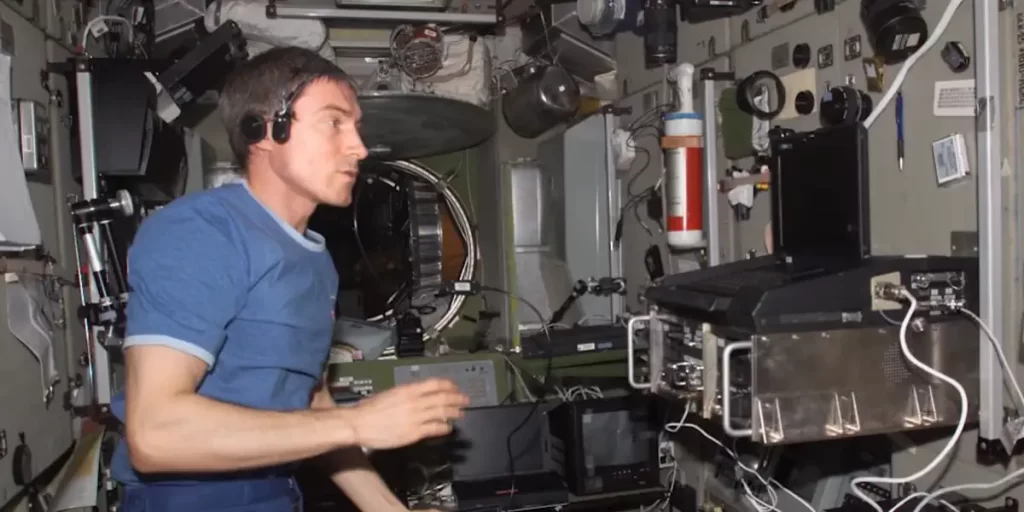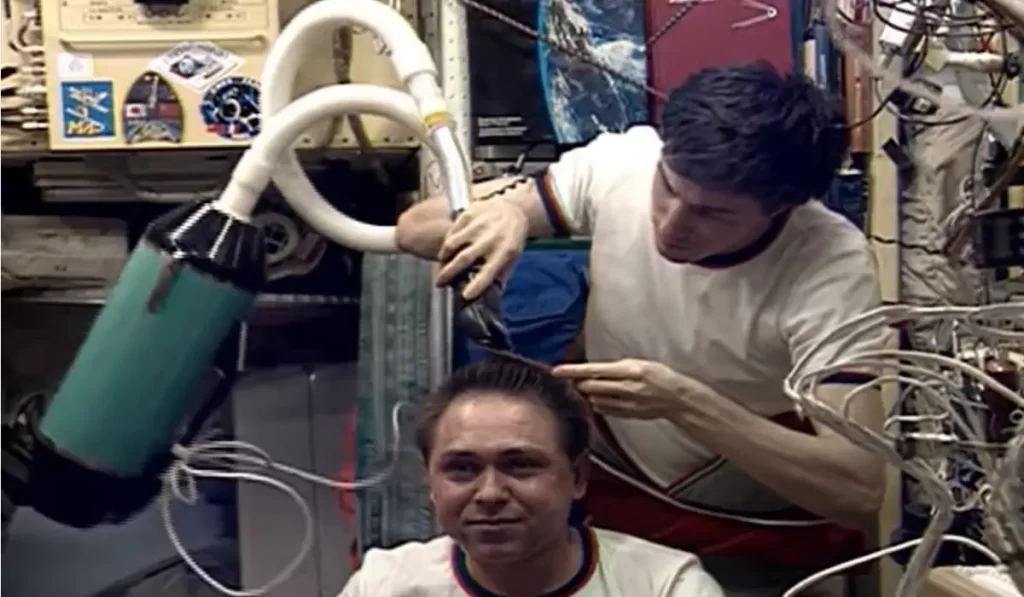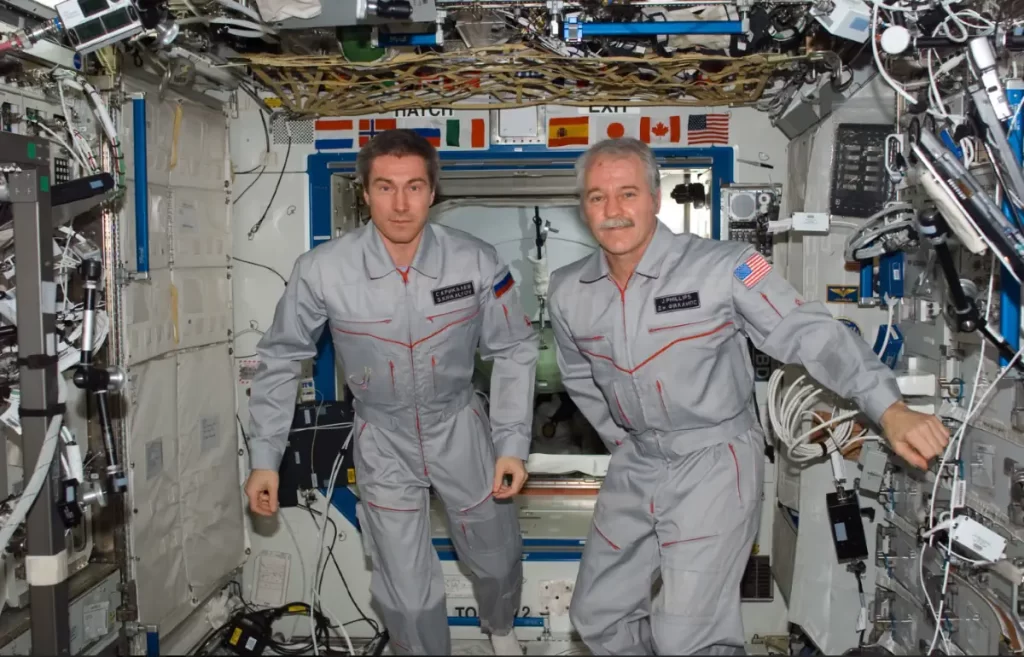Soviet cosmonaut Sergei Krikalev (born August 27, 1958) was in space when the Soviet Union fell apart in 1991. He was stranded on board the Mir Space Station during the dissolution of the USSR. As the country that had sent him into space no longer existed, his return was delayed until further notice. He stayed in orbit for 311 consecutive days, twice as long as the original duration of the mission. He eventually returned back to earth – to a very different nation.

Sergei Krikalev
Krikalev was born in Leningrad (today’s Saint Petersburg) in the Soviet Union in 1958. He was selected as a cosmonaut in 1985.
His first spaceflight was in 1988 as a flight engineer on a Soyuz TM-7 that was launched on November 26, 1988. Other crewmembers were Commander Aleksandr Volkov (USSR), and French astronaut Jean-Loup Chrétien. They conduct scientific experiments aboard the Mir Space Station. They also prepared the station for a period of uncrewed operations and performed 6 spacewalks. The crew returned to Earth on April 27, 1989, spending 151 days aboard the Mir.
When they arrived at the space station, the previous crew (Vladimir Titov, Musa Manarov, and Valeri Polyakov) were still there and remained on Mir for another 25 days. This period marked the longest period a six-person crew had been in orbit at the time. Today, it’s a regular practice aboard the International Space Station.
Communicating with the amateur radio operators on Earth
When in orbit, Krikalev regularly communicated with the amateur radio operators (hams) on the ground, an activity he would continue throughout his career as a cosmonaut.
He formed a close relationship with an amateur radio operator named Margaret Iaquinto. They successfully communicated via packet radio for the first time in history between an orbiting space station and an amateur radio operator.

Stranded in Space
On May 19, 1991, Krikalev went into space for the second time aboard the Soyuz TM-12, again as a flight engineer. Other crew members were Commander Anatoly Artsebarsky (USSR) and the British astronaut Helen Sharman, the first Briton in space.
Before this flight, he was married to Yelena Terekhina. She was a ground engineer at RSC Energia, the Russian manufacturer of ballistic missiles, spacecraft, and space station components. Krikalev also regularly communicated with her via radio when he was in orbit and eventually fell in love with her.
As the Soyuz TM-12 approached Mir, the automatic docking system failed. Sherman was worried, but, she would later reveal that Krikalev was calm and collected under the very pressing circumstances. He performed a manual docking to the Mir.
After just eight days Sharman returned to Earth with the previous crew. Krikalev and Artsebarsky remained aboard Mir during the summer. They performed six EVAs (Extravehicular Activity or spacewalk) and performed scientific experiments as well as some space station maintenance tasks.
In July 1991, as the next two planned spaceflights to the Mir Space Station had been reduced to one due to economic difficulties the Soviet Union experiencing, Krikalev agreed to stay on Mir as the flight engineer for the next crew. Because the flight engineer who was sent on that mission was not trained for long-duration missions in space.
On October 10, 1991, Artsebarsky returned back to Earth and Krikalev remained on the station with the commander Alexandr Volkov.

As the two cosmonauts perform their duties aboard the Mir Space Station, the country that had sent him into space has begun collapsing.
Krikalev’s radio-operator friend, Margaret Iaquinto set up a makeshift digital bulletin board that the Mir cosmonauts would often use to obtain uncensored Western news. The cosmonaut’s wife Yelena also regularly communicated with him. Now she was taking care of their 9-month-old daughter all by herself.
On the ground, the situation was getting worrying. In August 1991, a failed attempt made by communist hard-liners of the Soviet Union to take control of the country from Mikhail Gorbachev, the Soviet coup d’état attempt, also known as the August Coup, destabilized the nation even further. The future of the Soviet space program went into uncertainty.
To overcome the economical difficulties, the Soviet Union started selling seats on its spaceflights to foreign governments. There were also rumors that the Mir Space Station will be sold.
An escape option was available
As in the case of the International Space Station, one Soyuz capsule is always remained attached to the Mir to allow a quick return in an emergency. Krikalev and Volkov could use it, but that would have meant leaving the Mir to its own fate. This would mean most likely the end for the valuable space station.
So, despite the uncertainties, the two cosmonauts continued their daily routines and maintained the space station, keeping it under working condition.
Krikalev, the last citizen of the Union of Soviet Socialist Republics (USSR)
The USSR officially came to its end on December 26, 1991. The two cosmonauts about 250 miles (400 km) above were one of the last things on the priorities list for the nations that formed the Soviet Union.
With no end to his mission in sight, Krikalev started being worried. He recalls he questioned himself: “Do I have enough strength? Can I be able to readjust myself for this longer stay to complete the program? Naturally, at one point, I had my doubts.”
In January 1992, as the Russian Progress M10 uncrewed supply ship reached the station, they finally received supplies including food, water oxygen, and mail. It carried the fourth VBK-Raduga capsule, which was used to return experiment results and equipment to Earth when the Progress was deorbited.
After retrieving the contents of the VBK-Raduga capsule, they reloaded it with data, samples, and the results of scientific experiments. Progress M-10 was undocked from Mir at 07:13:44 GMT on 20 January 1992 and was deorbited a few hours later to a destructive reentry over the Pacific Ocean. The Raduga capsule landed at 12:03:30 GMT.
One week later, another supply craft arrived: the Progress M11. However, the workers at ground control went on a strike to demand better wages, and that nearly compromised the arrival of the M11. Fortunately, Krikalev and Volkov were able to coordinate the arrival despite minimal support from the ground.
On February 20, 1992, Krikalev and Volkov performed a spacewalk, the first EVA conducted following the collapse of the USSR. They retrieved the work platform installed on Kvant-1 prior to the construction of the Sofora truss, cleaned a TV camera lens on Kvant-1, retrieved the telemetered panel from the core module’s dorsal solar array, and retrieved exposure cassettes from around Kvant-2’s airlock.
During the initial stages of the EVA, the heat exchanger in Volkov’s spacesuit failed and he relied on an umbilical from Kvant-2 for life support for the rest of the EVA.
The cosmonauts’ extended stay was coming to an end. On March 17, 1992, Soyuz TM-14, the 14th expedition to the Mir space station was launched. It was the first Russian Soyuz mission after the collapse of the Soviet Union.
The TM-14 crew included two Russian cosmonauts, Aleksandr Viktorenko and Aleksandr Kaleri, and a German astronaut, Klaus Dietrich Flade, who became the second German to visit a space station when he reached Mir. The first was Sigmund Jähn (13 February 1937 – 21 September 2019) of East Germany, who visited Salyut 6 in 1978.
Flade stayed with Krikalev and Volkov for a couple of days, and finally, on March 25, 1992, they boarded Soyuz TM-14 and returned back to Earth.
Krikalev was dubbed the last Soviet cosmonaut of the USSR. While in space, he and Volkov saw the country that had sent them into space falling apart, and Krikalev’s hometown, Leningrad, becoming Saint Petersburg.
Their story is documented and contextualized in Romanian filmmaker Andrei Ujică’s 1995 documentary Out of the Present. Krikalev’s story also inspired the 2017 Cuban film Sergio & Sergei, directed by Ernesto Daranas.
Space Shuttle
Krikalev also flew on STS-60, the first joint U.S.-Russian Space Shuttle Mission, which was launched on February 3, 1994. He conducted significant portions of the Remote Manipulator System (RMS, Canadarm, or Canadarm1) operations during the flight.
He also flew on STS-88 Endeavour (4-15 December 1998), the first International Space Station assembly mission. During the 12-day mission, the Unity module was mated with the Zarya module. The crew also deployed two satellites, Mighty Sat 1 and SAC-A.
International Space Station
Krikalev was also a member of the Expedition 1 crew – the first expedition to the orbiting laboratory, which was launched on October 31, 2000, on a Soyuz rocket from Baikonur Cosmodrome in Kazakhstan. The crew was:
- Commander: William Shepherd, NASA (fourth and last spaceflight)
- Flight Engineer 1: Yuri Gidzenko, RSA (second spaceflight)
- Flight Engineer 2: Sergei Krikalev, RSA (fifth spaceflight)
Krikalev was also the Commander of Expedition 11, which was launched on April 25, 2005. It was his sixth and last spaceflight. He lived and worked aboard the International Space Station on a six-month tour of duty.
With that last mission, Krikalev logged 803 days and 9 hours and 39 minutes in space, including eight EVAs. As of January 2022, he is currently third to Gennady Padalka and Yuri Malenchenko in the record for the most time spent in space.
Two things [are my favorite part of being up in Space]. Firstly, the view of Earth from the viewing port. Secondly, the sense of freedom which you experience in weightlessness, you feel like a bird that is able to fly!
Sergei Krikalev

Sources
- Sergei Krikalev on Wikipedia
- Sergei Konstantinovich Krikalev on the European Space Agency website
- Progress M-10 on Wikipedia
- List of Mir Spacewalks on Wikipedia
- Soyuz TM-14 on Wikipedia
- Expedition 1 on Wikipedia
- Expedition 11 on Wikipedia
- “I was a Russian cosmonaut in space as the Soviet Union collapsed – your questions answered” on The Guardian
- Moon Landings: All-Time List [1966-2025] - February 2, 2025
- What Is Max-Q and Why Is It Important During Rocket Launches? - January 16, 2025
- Top 10 Tallest Rockets Ever Launched [2025 Update] - January 16, 2025
